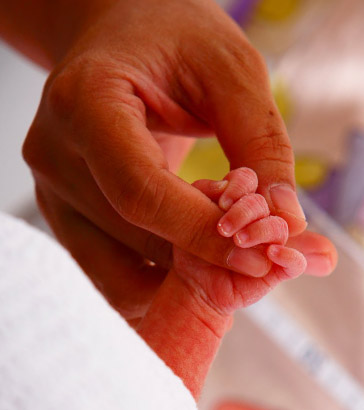
- There is growing evidence to suggest that foetal body and brain development can be effected in the uterus by smoking and taking illegal drugs during pregnancy.
- When researching the effects of prenatal exposure to specific drugs it is hard to determine the full extent of impact because separating external contributing factors is complicated.
- There is data relating to some drugs but not others.
A summary of available evidence is presented in the following screens.

It is well established that smoking cigarettes or shisha tobacco during pregnancy can cause miscarriage, premature labour and low birth weight babies (Cnattingius, 2004; BBC, 2009). Cigarettes restrict the essential oxygen supply to the foetus, which can limit growth.
Longer term effects of smoking on the developing child have not have not been clinically confirmed, however some studies have found links between smoking during pregnancy and conduct disorders, hyperactivity and inattention in young children. (NHS, 2009; Cnattingius, 2004).

Evidence suggests that cocaine use during pregnancy:
- Limits foetal growth, interferes with nervous system development, and increases risk of premature birth (eg March of Dimes, 2008; Baby Centre, 2010), and
- Can cause babies to be born with smaller heads, something which is often linked to learning difficulties in later life (March of Dimes, 2008).
Initial behavioural problems such as irritability, being easily startled and excessive crying are said to subside after the first year (March of Dimes, 2008).
There is conflicting evidence about the longer-term consequences of cocaine use.

Heroin used during pregnancy passes through the placenta to the foetus. At birth, levels of the drug can be found in the bloodstream of the baby. This can lead to babies presenting withdrawal symptoms known as neonatal opiate abstinence syndrome (NOAS).
Evidence suggests that a foetus exposed to heroin in the uterus is at risk of premature birth and reduced birth weight (Baby Centre, 2010) and factors linked to learning difficulties in later life.
As with other drugs, the long-term effects of heroin use during pregnancy is less known, partly due to the difficulty in separating drug use from other contributing factors.

There is evidence to suggests that:
- Mothers smoking cannabis during pregnancy may increase the chances of premature birth and low birth weight (March of Dimes, 2008; Hall and Solowij 1998), however it is unclear the extent to which this is related to the effects of smoking tobacco with cannabis, and
- Infants exposed to cannabis in the uterus have behavioural and developmental effects during the first few months after birth.

With limited research-based evidence about the effects of specific drugs on the child's long term development and many environmental influences that compound development, at this stage, there are no clear implications for teaching and learning.
In such cases it is best to teach to the learning styles of individual children and consider the behaviours they present, rather than focusing on the neurological basis of their difficulties.

Children are at risk of developing 'secondary' disabilities if their parents are drug users or if there is a stressful home environment. Secondary disabilities include mental health and attachment problems, learning difficulties and/or behavioural issues.

Baby Centre (2010). Illegal drugs in pregnancy.[Accessed on 25 February 2012]
BBC (2009). Shisha 'as harmful as cigarettes'. [Accessed on 25 February 2012]
Chasnoff, I. J., Anson, A., Hatcher, R., Stenson, H., Iaukea, K. and Randolph, L. (2008). Prenatal exposure to cocaine and other drugs: outcome at four to six years. Annals of the New York Academy of Sciences, 846, 314-328.
Cnattingius, S. (2004). The epidemiology of smoking during pregnancy: Smoking prevalence, maternal characteristics, and pregnancy outcomes. Nicotine and Tobacco Research, 6, 125-140.

Heroinbabies (2007). An overview of heroin and its teratogenic effect on infant and fetal development. [Acccessed on 25 February 2012].
March of Dimes.com (2008). Illicit drug use during pregnancy. [Accessed on 25 February 2012].
Meade, C. (2007). The effects of substance abuse on the development of children. [Accessed on 25 February 2012].
NHS (2009). Pregnant smoking linked to child tantrums. [Accessed on 25 February 2012].

Riggins, T., Schweitzer, J., Kurup, P., Ross, T., Black, M. and Salmeron, BJ. (2008). Effects of prenatal drug exposure on adolescent brain activation during a visuospatial working memory task. [Acccessed on 25 February 2012].
Wang, M. (2010). Perinatal drug abuse and neonatal drug withdrawal. [Accessed on 25 February 2012].